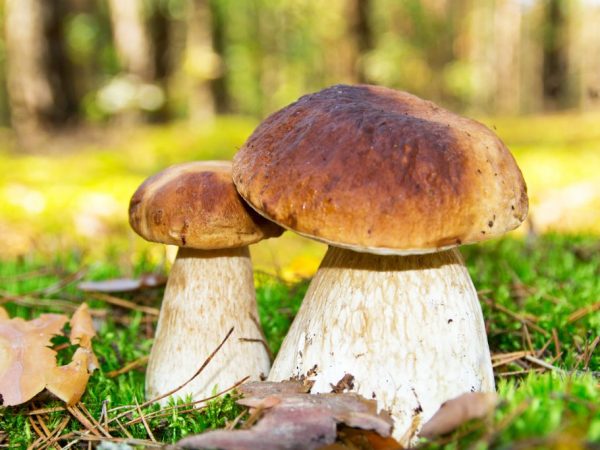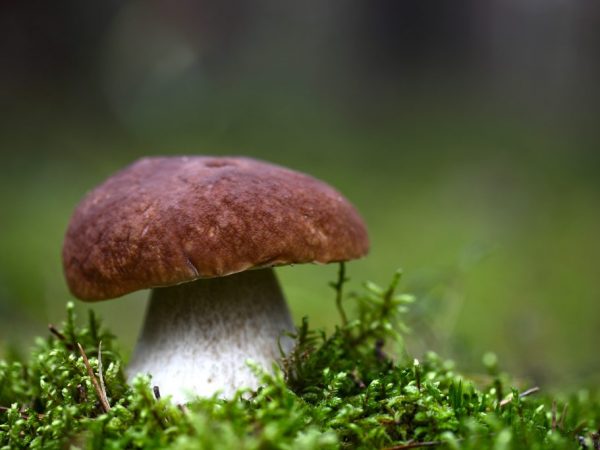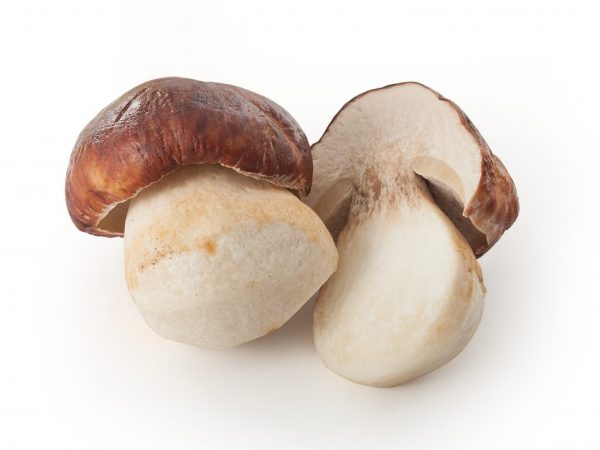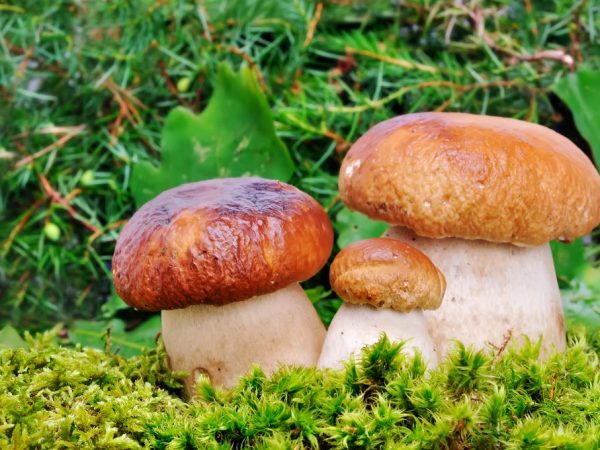Description of porcini mushroom
"Mushroom king" - as the people call the white mushroom (boletus). It differs from its counterparts in its excellent taste and useful properties. Porcini mushrooms have many varieties, which are quite widespread throughout Russia; they are used not only in cooking, but also in medicine. They are in great demand among mushroom pickers, so there is a way to grow it even at home.

Description of porcini mushroom
Description of the mushroom
White mushroom is often called simply "white" or, in another way - "boletus".
The peculiarity of this kind of mushrooms is that even when dried, it retains its natural pulp color. Another distinguishing feature is the unique, characteristic aroma.
The cap of the porcini mushroom is below the spongy structure, milky in color. Interesting fact: the shape of the cap can be used to judge the age of the fruiting body. In young people, the structure is clear, rounded, but in adults it is flatter.
Appearance
Description of porcini mushroom:
- Pulp: fleshy, white and juicy in young specimens, but in mature ones it is yellowish.
- Hat: velvety, dark brown (30-35 cm in diameter). There were cases when mushroom pickers managed to find rare specimens in the oak forest, in which it grew up to 50-60 cm.
- Hymenophore: tubular, or spongy, with a deep recess at the stem, easily separates from the bottom of the cap.
- Leg: usually quite tall (10-12 cm), the color ranges from grayish-white to dark brown. Sometimes you come across real forest giants, which reach a height of 25-30 cm, and look impressive. Depending on the age, the shape of the leg also changes. In young specimens, it looks like a barrel, while the old mushroom gradually decreases in size, and its base dries out.
Where grow
Porcini mushrooms grow in different places: it is found in the forests of Russia, in Mexico and in the African tropics.
The development cycle is directly dependent on weather conditions. In temperate climates, fruiting bodies ripen in late May and early June. Autumn is considered a mushroom season, because until the end of November, you can harvest a generous and tasty harvest.
According to the description, they live in colonies, i.e. several dozen specimens appear on one piece of land. They are especially active during the good rain season.
Habitats of porcini mushrooms: grow under a pine, birch, oak, in open and sunny meadows or in a meadow. Loves mossy soil.
If you are going on a "quiet hunt" for the first time, contact an experienced mushroom picker who will tell you where you can harvest.
Types of boletus

All types of porcini mushrooms can be eaten
Edible white mushroom varieties are classified as follows:
- B. dark bronze: you can distinguish this species by the color of the cap. For boletus copper, or bronze, a brown color of the cap is characteristic. Usually the body comes in all sizes. There are both small and large individuals. Inside, the pulp of the mushroom is white. You can be convinced of this by seeing a handsome man in a cut.Boletus has a pleasant taste, which remains even after heat treatment of the product. They are easy to find in autumn in mixed and coniferous forests (pine forest), under green pine or spruce.
- B. mesh: this species is similar in appearance to a flywheel. He has the same leg, shaped like a cylinder, and a large cap (from 10 to 35 cm). It is popular for its taste. The likelihood of finding a white mushroom netting is high not only in Russia, but also in European countries, as well as the United States. Many boletus mushrooms appear in forest glades at the end of May.
- B. birch: the name comes from the habitat of the boletus common for this species - birch groves. The hat is yellowish-brown in color, not convex. The leg is brown from 9 to 12 cm. The spores of the fungus are small. This species is different between its fellows - it does not darken in cross-section and does not acquire a black color. Leg with pink piping. Mushroom thickets appear several times a year. It is better to look for them in the autumn. They grow on soil that is rich in trace elements.
- B. pine: a large cap up to 15 cm in diameter, characterized by a purple color, tasty fleshy flesh, a squat leg. Do not be surprised if you hear the phrase: "The pine porcini mushroom got embarrassed and completely turned pink." In the context of the boletus, they differ in burgundy color. Their homeland is pine forests; it is impossible to find these representatives of the kingdom of Mushrooms on the meadow plain. Rainy weather is necessary for them to rise and produce crops. The best time for active growth is spring.
- B. royal: the largest of all varieties of porcini mushrooms. The habitat of this handsome man is pine and deciduous forest. Its dimensions: cap - from 20 to 35 cm in diameter, leg height - 10-15 cm. Unusual color - crimson-violet. The pulp is juicy and firm, gradually changing its color to pink. For this species to grow in the soil, heavy rain is needed.
- B. oak: this species has become a favorite for its nutritional value. White oak mushroom has no characteristic odor. It is in demand because of its size (12-20 cm), a velvety brown cap with a grayish tint and a large leg. Usually, the top of the cap is covered with a film - a skin that becomes sticky in wet weather. The skin grows tightly with the surface of the cap and it is almost impossible to remove it. The pulp is looser, the taste is sweetish.
- B. spruce: the edible hat is distinguished by a maroon or chestnut color. The top layer of the cap is rough. The leg is even, massive, elongated, covered with a light mesh on top. White spruce mushroom feels great on the ground, which is covered with dry needles.
- B. yellow: the cap of the mushroom is golden white. Its shape is convex, reminiscent of a pillow. The surface is smooth. In wet weather, it is covered with a reticular slimy plaque. The first layer is elastic, but over time, deep cracks begin to cover the mushroom. Boletus grows on a thick stalk that does not have a mesh. The surface of the leg may be covered with small scales. The cut site turns blue quickly. The composition of this product includes a lot of trace elements useful for human health. The king of the forest has a memorable taste.
The types of porcini mushrooms are very diverse, they are allowed to be eaten. Boletus are mycorrhiza formers. They usually enter into symbiosis with various deciduous and coniferous woody plants.
Irina Selyutina (Biologist):
Thanks to folk perceptiveness, a connection was noted between the appearance of white and other types of mushrooms: the upland form of the white fungus appears almost simultaneously with green leaves in autumn, in oak forests - with green russula, and in birch forests - with chanterelles.
For his development he prefers:
- well-drained soils, but without waterlogging (sandy, sandy loam, loamy). Avoids peat and bog soils;
- trees over 50 years old, forests with formed moss and lichen cover.However, at the same time, in pine forests, the maximum yields of this fungus can be harvested if the trees are 20-25 years old.
The optimum temperature for the development of fruiting bodies is + 15 ... + 18 ° C in July and August, as well as + 8 ... + 10 ° C in September. But large fluctuations in day and night temperatures, a large amount of precipitation lead to a reduction or complete cessation of the development of fungi. In mass, the porcini mushroom appears after short-term thunderstorms and foggy warm nights.
The white mushroom in the process of evolution has inhabited almost all continents of the Northern Hemisphere. It was brought to the continents of the southern hemisphere with seedlings of mycorrhizal coniferous trees.
Despite its wide distribution, the porcini mushroom is still absent in some places in the wild. And then mushrooms in those areas are called "white" mushrooms that have a really white or very light color of the fruit body, but are not real boletus. Examples of such "doubles" can be white boletus, giant talker, steppe oyster mushroom (steppe white mushroom).
Beneficial features
The porcini mushroom is said to be a storehouse of nutrients. The product contains trace elements that are necessary for humans to overcome many diseases.
Beneficial features:
- The composition contains selenium. It prevents “activated cancer” cells from multiplying.
- The chemical composition includes vitamin C. The properties of ascorbic acid make it possible to maintain the vitality of the human body. Appetite improves, the immune system is restored, insomnia disappears.
- All types of porcini mushrooms contain the vital material for our bones - calcium. By including this product in the diet, you will make up for the lack of the following trace elements - iron, potassium, as well as B vitamins, which will help improve memory, restore the functioning of the nervous system, and resume blood circulation in the brain.
- Helps cleanse the blood.
- Vitamin A is essential for maintaining the beauty and health of the skin.
- Eating porcini mushrooms will help regulate the thyroid gland.
Boletus harm

Boletus is not suitable for feeding children
The energy value of the porcini mushroom is high, but at the same time, care should be taken. It is categorically contraindicated in pregnancy and for feeding children.
Negative characteristic:
- The life cycle of the porcini mushroom is extremely small, so it is easy for them (overripe fruiting body) to be poisoned.
- Difficult to digest, which sometimes causes upset of the digestive system.
- The chitin content negatively affects the functioning of the kidneys.
- Absorbs harmful substances from the environment.
- The "kings" of the forest are strong allergens, so you should use them with great care.
- There are poisonous counterparts, in particular the gall fungus. It is easy to distinguish these mushrooms by the color of the hymenophore. In the gall boletus, the inner part of the cap is red, and it also has a looser pulp structure.
The value of the porcini mushroom is unique, but when eating this product, be careful, focusing on the characteristics of your health, because if improperly processed, it releases harmful substances.
Mode of application
BZHU - 35 kcal per 100 g. In porcini mushrooms, the calorie content depends on the method of preparation. It is cooked fried, boiled, stewed and dried, pickled for the winter. In medicine, they use infusions and decoctions based on mushroom broth.
In cooking
Porcini mushrooms taste good, which is why they are highly prized in cooking. Their usefulness is due to the unique fats and carbohydrates in the composition - they are necessary to maintain normal health.
For cooking, only fresh are suitable, stored raw for some time can be poisoned.
The largest amount of useful microelements enters the human body in dried form (75-80%).
Before cooking, it is worth checking the edibility of boletus. This is easy to do: add onions to boiling water when cooking.If it turns blue, it is better not to use the product, because it contains bitter poisonous substances.
Light soups are made from it (broth based on it is considered as useful as chicken), snacks, salads, baking fillings, main dishes, sauces. Among other products, boletus mushrooms are distinguished by the fact that they do not cook for a long time. Boil them for 5-7 minutes.
This product must be soaked before cooking. Store ready meals in a cool place, preferably in the refrigerator.
In medicine
In the forests, porcini mushrooms grow, which are used by traditional healers. Alcohol tincture, broth, fresh juice or powder are considered traditional medicine.
- treat diseases of the cardiac and venous systems;
- strengthen the body's defenses;
- serve as the prevention of pulmonary tuberculosis;
- kill parasites;
- improve the condition of the genitourinary system.
Eating porcini mushrooms stimulates cell renewal. The content of the product allows the human body to independently cope with many diseases: cardiovascular, physical and mental fatigue, prevention of infakt, stroke, oncological neoplasms, increased immunity, normalization of metabolism.
To prepare a remedy, fill a liter jar with well-washed, dried and cut boletus caps and fill it with high-quality vodka so as to cover the product. The tincture is prepared for 15 days in a dark, warm place. After that, it is filtered, the raw material is squeezed out and poured into a container that will be stored in the refrigerator. Take 2 times a day, 30 minutes before meals, 1 tsp. with a little cold boiled water. This drug is stored for the winter, it tastes bitter. The course is usually 1-3 months, depending on the disease. If you want to improve your well-being with varicose veins or thrombophlebitis, then in parallel with the ingestion of the tincture, rub it into the problem areas of the lower extremities.
Pregnant women should not be treated this way. The medicine is dangerous for the health of the unborn baby; people with severe pathologies and with individual intolerance to the components are also included in the risk group.
Attention! Before taking the tincture, you should consult with your doctor.
Growing methods

Mushrooms can be grown in the garden
Cultivation of porcini mushrooms in a personal plot is easy to organize. The easiest way is to grow them in the garden with your own hands. The plant reproduces in two main ways.
From mycelium
To create a mushroom garden at home, you need to grow "seeds". Purchase mycelium (spores) from a specialty store. Such seedlings are not uncommon, because many people want to have homemade boletus.
Prepare the soil in advance, immediately after the snow melts. The best place is the ground around the trees. Oak, green pine and birch are suitable, i.e. symbiont trees. Clear around them 1.5-2 m from all plants - this is where the planting site will be.
Fertilize the soil before planting spores. Use organic matter - peat, compost. Then try to seed the soil evenly with mycelium. Don't forget to water it well. Wait for the mushroom filaments to appear on thin legs, and insulate the mycelium in the winter with straw.
It is not difficult to breed a porcini mushroom in a summer cottage in this way. The harvest is allowed to be harvested as early as next spring. Usually one mycelium bears fruit for no more than 4-5 years.
From hats
To plant porcini mushrooms in a similar way, prepare boletus caps: separate them from the stem and put them in the sun to ripen. The size of the caps should be at least 5-10 cm in diameter. Please note that boletus will need to be planted in the same place where they grew earlier. This planting will preserve the best mushroom specimens.
The dried caps are soaked in water for a day, and then rubbed with hands into a homogeneous gruel.Having squeezed out the raw materials with gauze, you get mushroom spores (in water), which you can use for further breeding boletus. Sow the mycelium, carefully spreading it over the entire surface of the planting site, after which it is regularly watered and checked so that the mycelium does not start to rot.
Conclusion
Boletus has a different name - porcini mushrooms. Tasty and edible varieties of porcini mushrooms are used not only for food, but also in folk medicine, they act as an excellent prophylactic agent against many diseases. They are inexpensive, while they contain many nutrients and few calories.
You can grow in your garden, following simple rules for care. In the wild, there are examples of mycorrhiza of woody plants, both deciduous and coniferous with this fungus.



